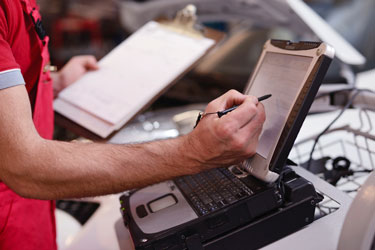 Sometimes accuracy isn’t all that important, such as in a game of horseshoes or when tossing a hand grenade. But the same can’t be said for diagnosing today’s cars.
Sometimes accuracy isn’t all that important, such as in a game of horseshoes or when tossing a hand grenade. But the same can’t be said for diagnosing today’s cars.
Close isn’t good enough if you want to establish credibility in your local market. Today’s professional technician can’t just grab a component hanging from a branch of the proverbial parts tree and see if that will fix the problem. It requires a diligent effort of testing and diagnostic time to analyze the maze of electronic data. That’s not to say a consumer won’t stumble across a repair shop that still uses the hand grenade method in diagnosing their car. Believe me, they’re still out there.
Basically, there are two types of mechanics a consumer will run into: One who will test and retest before condemning a component, and the other who will swap parts until they’ve solved the problem (or at least until they give up and send the customer to the first type of mechanic).
To avoid the proverbial slinging of the horseshoe, a good shop will listen to the customer’s complaint, follow the diagnostic procedures, and base their findings on the test results. It’s a far better way of solving a problem than firing the ol’ parts cannon at a job.
Take a look at any training video out there. They’ll show you how a component or system functions and then get into how to test it for failures. In all situations, the concept is to show the technician various ways of testing.
Seriously, have you ever watched a training video that told you to fire up the parts cannon and take a wild shot at it rather than testing for the failure? I haven’t.
So, why are parts-swapping repair shops still a big part of the automotive repair business? In my opinion, it’s the lack of training, the inability to find time for advanced classes, or the belief the tech can get by without learning something new. These techs spend as little time as possible diagnosing, while spending the majority of their time taking stabs at installing different parts that might be the problem. Eventually, they’ll hit the target.
Of course, when a customer who has already lost their patience finally makes it to a shop that will actually diagnose their problem, they’re bound to say, “I’ve already had it tested, so I don’t need to pay you to test it again.” Now that’s funny. The inability to get their vehicle tested and diagnosed correctly is exactly why they showed up at your shop in the first place.
A good example of this scenario played out when a rather heated customer whose car had a miss after a tune-up at another shop came into the new shop looking for service. The first shop had tossed the proverbial parts grenade at the car and had given up. They tried sensors, computers and just about every other part they could think of. Then, the tech at the new shop looked the vehicle over with his scanner, and to back up the scanner results, he pulled out his scope and checked it in a completely different way than the scanner did.
Looking at the secondary ignition trace, he could clearly see a problem with the spark plug. The problem turned out to be a brand new spark plug that had a slight crack in the porcelain.
Now, how long did it take to make the actual repair? Not long at all. But, how long did it take to set up the scope, do the testing, and verify the results? Probably twice as long as it took to change the plug.
Parts swapping without testing, or simply going off a code as a solution to today’s car problems, is like playing with horseshoes or hand grenades. You’re going to get it right some of the time, but that’s just sheer luck. You have to ask yourself, “Is ‘close enough’ good enough when you’re diagnosing and repairing today’s cars for a paying customer?” I think not.
Courtesy Underhood Service.














